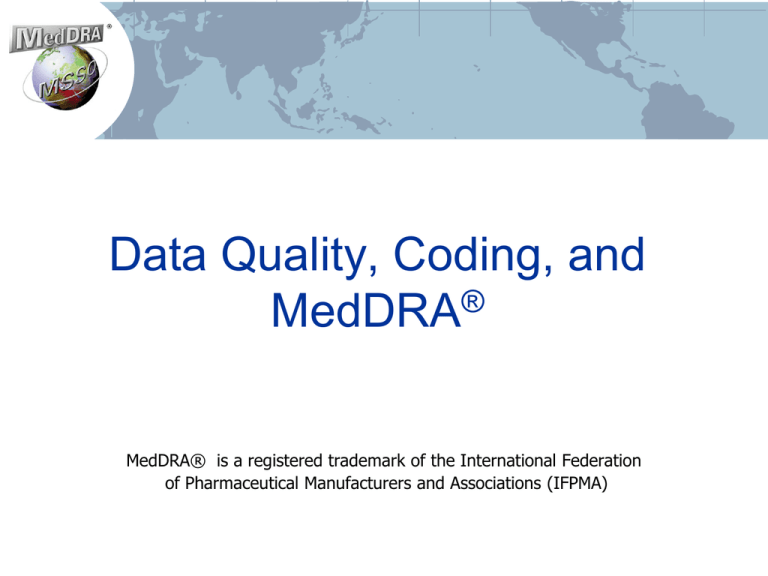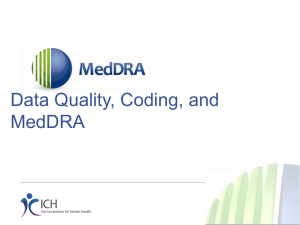
Data Quality, Coding, and
MedDRA®
MedDRA® is a registered trademark of the International Federation
of Pharmaceutical Manufacturers and Associations (IFPMA)
Course Overview
To provide an understanding of:
•
•
•
•
•
Importance of good quality data
How clinical data are coded
MedDRA background
Coding examples
Benefits of good quality data
MSSO-DI-6225-14.0.0
© 2011 Northrop Grumman Corporation. All Rights Reserved.
2
Data Quality in Clinical
Development
• Highly regulated environment with strong
emphasis on safety surveillance and data
quality
• Applies to clinical trials and post-marketing
arena
• Increasing harmonization of safety
reporting regulations globally
MSSO-DI-6225-14.0.0
© 2011 Northrop Grumman Corporation. All Rights Reserved.
3
What is Meant by
Good Quality Data?
• Complete
• Accurate
• Diagnosis supported by appropriate
investigations
• Causality assessment for adverse
events
MSSO-DI-6225-14.0.0
© 2011 Northrop Grumman Corporation. All Rights Reserved.
4
Quality of Input = Quality of Output
IN
MSSO-DI-6225-14.0.0
© 2011 Northrop Grumman Corporation. All Rights Reserved.
OUT
5
Coding of Clinical Trial Data
• Most data entered on Case Report Forms are “coded”
in some form
• Facilitates storage, retrieval, analysis, and
presentation of data
• Some coding is performed by investigators at point of
data entry
– For example, numeric codes for severity of adverse event:
1= mild, 2= moderate, etc.
• Other coding of text data is performed by the
sponsor company after data collection
• Accuracy of initial coding determines accuracy of
analysis
MSSO-DI-6225-14.0.0
© 2011 Northrop Grumman Corporation. All Rights Reserved.
6
MedDRA Background
What is MedDRA?
Med = Medical
D = Dictionary for
R = Regulatory
A = Activities
MSSO-DI-6225-14.0.0
© 2011 Northrop Grumman Corporation. All Rights Reserved.
8
MedDRA Definition
MedDRA is a clinically-validated
international medical terminology used
by regulatory authorities and the
regulated biopharmaceutical industry.
The terminology is used through the
entire regulatory process, from premarketing to post-marketing, and for
data entry, retrieval, evaluation, and
presentation.
MSSO-DI-6225-14.0.0
© 2011 Northrop Grumman Corporation. All Rights Reserved.
9
Key Features of MedDRA
• Standardized terminology
• International scope – currently available
in 11 languages including English,
Spanish, French, Chinese, and Japanese
• Managed by Maintenance and Support
Services Organization (MSSO) and
updated bi-annually with input from
subscribers
MSSO-DI-6225-14.0.0
© 2011 Northrop Grumman Corporation. All Rights Reserved.
10
Key Features of MedDRA (cont)
• Structure facilitates data analysis and
reporting and electronic communication
• Large terminology with > 69,000 terms at
lowest level - allows greater specificity
• Approx. 19,000 Preferred Terms, each
representing a unique medical concept
• Used for coding adverse events, signs and
symptoms, procedures, investigations,
indications, and medical and social histories
MSSO-DI-6225-14.0.0
© 2011 Northrop Grumman Corporation. All Rights Reserved.
11
Regulatory Status of Mandate
• US FDA
– Used in several FDA databases (AERS, VAERS, and
CAERS)
– Proposed Rule for Safety Reporting Requirements
(2003): MedDRA for postmarketing safety reports
• Japanese Ministry of Health, Labour and Welfare
– Mandatory use for electronic reports
– Used in Periodic Infection and Safety Reports
– For medical devices with biological components,
infections to be described with MedDRA terms
MSSO-DI-6225-14.0.0
© 2011 Northrop Grumman Corporation. All Rights Reserved.
12
Regulatory Status of Mandate (cont)
• European Union
– Clinical trials
• SUSARs (Suspected Unexpected Serious Adverse
Reactions) – use MedDRA LLTs (current or previous
version)
– Volume 9A (all authorized medicinal products,
including OTC)
• Individual Case Safety Reports (ICSRs) – use MedDRA
LLTs (current or previous version)
• For adverse reactions in Periodic Safety Update Report
• Standardised MedDRA Queries (SMQs) recommended
for signal detection
MSSO-DI-6225-14.0.0
© 2011 Northrop Grumman Corporation. All Rights Reserved.
13
Regulatory Status of Mandate (cont)
• European Union (cont)
– Interface between EudraVigilance and EU Risk
Management Plan
• To code indications, risks, interactions (potential
and identified)
– Summary of Product Characteristics guideline
• MedDRA to be used throughout; in particular for
Contraindications, Special warnings and
precautions for use, and Undesirable effects
sections
MSSO-DI-6225-14.0.0
© 2011 Northrop Grumman Corporation. All Rights Reserved.
14
Regulatory Status of Mandate (cont)
• ICH M4E Guideline on Common Technical
Document
– Recommended in adverse event summary tables
• Canada
– Guidance Document for Industry - Reporting Adverse
Reactions to Marketed Health Products
• Recommended as standard for adverse reaction reports
– Guidance for Industry - Product Monograph (labeling)
• Preferred terminology for adverse drug reactions
MSSO-DI-6225-14.0.0
© 2011 Northrop Grumman Corporation. All Rights Reserved.
15
Scope of MedDRA
Not a drug
dictionary
Patient demographic
terms
Clinical trial study
design terms
MSSO-DI-6225-14.0.0
OUT
IN
Frequency
qualifiers
Diseases
Diagnoses
Signs
Symptoms
Numerical values for
Therapeutic indications
results
Investigation names &
qualitative results
Medical & surgical procedures
Medical, social, family history
Medication errors
Severity descriptors
Product quality, device issues
Terms from other
terminologies
Not an equipment, device,
diagnostic product dictionary
© 2011 Northrop Grumman Corporation. All Rights Reserved.
16
Making the Most of MedDRA
• To take advantage of MedDRA’s richness and
specificity, the source data should be
–
–
–
–
Clear
Concise
Complete
Accurate
• General principles apply to all clinical data
MSSO-DI-6225-14.0.0
© 2011 Northrop Grumman Corporation. All Rights Reserved.
17
Problems With Coding Data
• Appropriate coding requires clear initial data
• What is clear to the investigator at the point of
data entry may be unclear to the sponsor at the
point of data coding
• Sponsor must only code reported verbatim term;
not permitted to interpret or draw information
from other sources
• Example: Ambiguous information
– Congestion (nasal, liver, sinus, pulmonary?)
– Cramp (muscle, menstrual, abdominal?)
– Pain (pain where?)
MSSO-DI-6225-14.0.0
© 2011 Northrop Grumman Corporation. All Rights Reserved.
18
Problems With Coding Data (cont)
• Example: Ambiguous abbreviations
– MI (myocardial infarction or mitral incompetence?)
– GU pain (gastric ulcer pain or genito-urinary pain?)
– Decreased BS (breath sounds, bowel sounds or
blood sugar?)
• Exercise caution with abbreviations that could
be misinterpreted
• ECG, COPD, HIV are examples of standard
abbreviations
MSSO-DI-6225-14.0.0
© 2011 Northrop Grumman Corporation. All Rights Reserved.
19
Problems With Coding Data (cont)
• Example: Vague information
– Patient felt “fuzzy”, “weird”, “experienced every
adverse event”
Try to use accepted medical terminology
• Example: Non-specific information
– “Left wrist edema” (coded as Peripheral edema)
– More specific - “Injection site edema left wrist”
(coded as Injection site edema)
MSSO-DI-6225-14.0.0
© 2011 Northrop Grumman Corporation. All Rights Reserved.
20
Problems With Coding Data (cont)
• Death, hospitalization, and disability are
outcomes and are not usually considered to be
adverse events
• Provide details of the underlying event, if
known
• Examples:
– “Death due to myocardial infarction” (Coded as
Myocardial infarction with death captured as the
outcome)
– “Hospitalization due to congestive heart failure”
(Coded as Congestive heart failure with
hospitalization captured as the outcome)
MSSO-DI-6225-14.0.0
© 2011 Northrop Grumman Corporation. All Rights Reserved.
21
Problems With Coding Data (cont)
• Example: Ambiguous laboratory data
– “Glucose of 40”
– (Source of specimen - blood, urine, CSF? What units?)
– Would have to code as Glucose abnormal if additional
clarification is not obtained
• Example: Conflicting laboratory data
– “Hyperkalemia with serum potassium of 1.6 mEq/L”
– Would have to code as Serum potassium abnormal
If using numeric values, provide units and reference
range. Be specific about specimen source and
diagnostic result/clinical diagnosis.
MSSO-DI-6225-14.0.0
© 2011 Northrop Grumman Corporation. All Rights Reserved.
22
Problems With Coding Data (cont)
• Example: Combination terms
– Diarrhea, nausea and vomiting
Try to avoid combination terms - these will have
to be split into three individual terms
Diarrhea
Nausea
Vomiting
MSSO-DI-6225-14.0.0
© 2011 Northrop Grumman Corporation. All Rights Reserved.
23
Reporting a Specific Diagnosis
• Where possible, report the most important
medical event or specific diagnosis rather than
individual signs and symptoms
• Can provide provisional diagnosis e.g.
“possible”, “presumed”, “rule out”
• Accuracy is important in preventing dilution of
safety signals or generating false signals
SIGNS and SYMPTOMS
Chest pain, dyspnea,
diaphoresis, ECG changes
MSSO-DI-6225-14.0.0
DIAGNOSIS
Myocardial infarction
© 2011 Northrop Grumman Corporation. All Rights Reserved.
24
Safety Signals
• Accuracy in diagnosis is important for detection
and evaluation of safety signals
• Events of importance in drug safety
surveillance include:
–
–
–
–
–
QTc prolongation
Hepatotoxicity
Stevens Johnson syndrome
Convulsions
Rhabdomyolysis
MSSO-DI-6225-14.0.0
© 2011 Northrop Grumman Corporation. All Rights Reserved.
25
Generating Quality Data
•
•
•
•
•
Clear
Concise
Complete
Accurate
Be specific if necessary - MedDRA can handle
multiple specific medical concepts:
– Headache - more than 50 types, including cluster,
sinus, migraine, lumbar puncture headache
– Organisms - down to species level e.g.
Staphylococcus aureus
MSSO-DI-6225-14.0.0
© 2011 Northrop Grumman Corporation. All Rights Reserved.
26
Quality Assurance
• Human oversight of automated coding
results
• Qualification of coder/review staff
• Errors in MedDRA should be addressed by
submission of Change Requests to MSSO;
no ad hoc structural alterations to
MedDRA
MSSO-DI-6225-14.0.0
© 2011 Northrop Grumman Corporation. All Rights Reserved.
27
FDA-Defined Coding Errors
• Missed Concepts
– All medical concepts described after the product is
taken should be coded
– Example: “The patient took drug X and developed
alopecia, increased LFTs and pancreatitis”.
Manufacturer only codes alopecia and increased
LFTs (missed concept of pancreatitis)
– Example: “The patient took drug X and developed
interstitial nephritis which later deteriorated into
renal failure”. Manufacturer only codes interstitial
nephritis (missed renal failure concept)
Acknowledgement: Dr. Toni Piazza-Hepp, Office of Surveillance
and Epidemiology, CDER
MSSO-DI-6225-14.0.0
© 2011 Northrop Grumman Corporation. All Rights Reserved.
28
FDA-Defined Coding Errors (cont)
• “Soft Coding”
– Selecting a term which is both less specific and less
severe than another MedDRA term is “soft coding”
– Example: “Liver failure” coded as hepatotoxicity or
increased LFTs
– Example: “Aplastic anemia” coded as unspecified
anemia
– Example: “Rash subsequently diagnosed as Stevens
Johnson syndrome” coded as rash
Acknowledgement: Dr. Toni Piazza-Hepp, Office of Surveillance
and Epidemiology, CDER
MSSO-DI-6225-14.0.0
© 2011 Northrop Grumman Corporation. All Rights Reserved.
29
–
–
–
–
–
–
–
–
–
–
–
–
–
–
Miscellaneous Verbatims:
Coding Challenges
Went to hell
Recurrent fatal stroke
Hears New Age music when the furnace turns on
LK RTCTL UNSP XTRNDL
Charcoal-like, gritty granules in his underwear
Can’t control patient during menses
His nodule is sticking out
Normally normal after drinking coffee
Died of cancer of the placebo
Superior members fornication
Barely visible posterior
Seeing people in room, seeing chickens at window
Seeing stars and chicken farting
Patient recently began new job where he works around chicken wings and
barbecue sauce
MSSO-DI-6225-14.0.0
© 2011 Northrop Grumman Corporation. All Rights Reserved.
30
Company-specific conventions
• Insert slides as required to cover company’s
specific data collection and recording
conventions
• Could include instructions on how to complete
data fields for adverse events, medical history
etc. on paper or electronic CRFs
• Could include general principles of how to
record text-based information as well as
specific instructions for particular therapeutic
areas
Benefits of Quality Data
• Accurate and timely information on issues that
affect conduct of clinical trial and affect patient
safety
• Improved communication among sponsors,
investigators, and regulatory agencies about
medicinal products
– Aids in safety signal detection and evaluation
– Ensures accuracy of information about the product
including investigators’ brochures and prescribing
information
– Benefits medical professionals
– Benefits patients
MSSO-DI-6225-14.0.0
© 2011 Northrop Grumman Corporation. All Rights Reserved.
32
Benefits of Quality Data (cont)
• Fewer queries for investigator and sponsor
MSSO-DI-6225-14.0.0
© 2011 Northrop Grumman Corporation. All Rights Reserved.
33
Quality Data
IN
MSSO-DI-6225-14.0.0
© 2011 Northrop Grumman Corporation. All Rights Reserved.
OUT
34
MSSO Contacts
• Mail
MedDRA MSSO
3975 Virginia Mallory Drive
Chantilly, VA, USA 20151
• Telephone
– Toll-free Worldwide 877.258.8280 (AT&T)
• Fax
– 703.272.5635
• Products and Services
– Toll-free Worldwide 877.258.8280 (AT&T)
MSSO-DI-6225-14.0.0
© 2011 Northrop Grumman Corporation. All Rights Reserved.
35
MSSO Contacts (cont)
• To Subscribe by
– E-mail
• mssosubscribe@ngc.com
– Web site
• www.meddramsso.com click on “Subscribe to MedDRA”
• Help desk
– Phone
• International AT&T Toll Free: 877.258.8280
• Direct Dial (USA): 703.272.5849
– E-mail
• mssohelp@ngc.com
MSSO-DI-6225-14.0.0
© 2011 Northrop Grumman Corporation. All Rights Reserved.
36
Useful Links
• Points to Consider documents
– http://www.meddramsso.com/subscriber_library_ptc.asp
• Regulatory Information
– http://www.meddramsso.com/public_aboutMedDRA_regulatory.asp
MSSO-DI-6225-14.0.0
© 2011 Northrop Grumman Corporation. All Rights Reserved.
37







